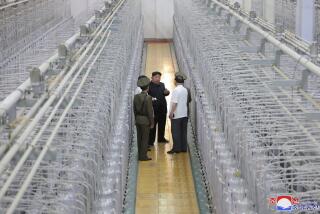In N. Korea, Weapons Are Key Instrument of Power
SEOUL — When North Korea first test-launched a missile capable of reaching Japan, the son of the country’s leader lavished praise and gifts on the researchers who had labored away on the project behind locked doors.
“You deserve to be sitting on a pile of gold for what you’ve done for our nation,” Kim Jong Il told the scientists shortly after the May 1994 launch, said a former employee of a Pyongyang-based institute that had worked on the project.
Kim, who would become leader after his father’s death a few months later, was even more excited when the scientists began work on a multistage missile that could hit the United States.
“We’ll be able to reach anyplace in the United States and the American bastards won’t be able to do anything to stop us,” Kim told the scientists, said the former employee, Kim Gil Sun.
During his visits, Kim Jong Il conferred on the scientists praise and prizes. There was no pile of gold, but there were watches with inscriptions from the leadership, color televisions, refrigerators and electric fans -- all luxuries in destitute North Korea.
The personal attention bestowed by the upper echelons of the regime goes a long way toward explaining how a failed state such as North Korea could have a military that threatens the world’s superpowers. North Korea test-fired seven missiles this month, and despite the multistage Taepodong’s failure, short- and mid-range missiles were believed to show surprising sophistication.
“They appeared to be accurate, validating the readiness of the North’s significant theater missile ballistic capability,” Army Gen. B.B. Bell, commander of U.S. troops in South Korea, told a defense forum this month in Seoul.
Although the North Korean army at one point was so poorly equipped that soldiers didn’t have socks, funding for the development of weapons of mass destruction -- particularly for the missiles and nuclear arms -- has increased.
“Kim Jong Il didn’t care if he bankrupted the rest of the country. He saw the missiles and nuclear weapons as the only way to maintain power,” said Kim Duk Hong, the former deputy director of the Juche Institute, a Pyongyang think tank devoted to North Korean ideology. He defected in 1997.
Because the regime is one of the world’s most secretive, information about the ways North Korea has nurtured its weapons programs can be gleaned only from defectors.
Kim Gil Sun, 50, spent 17 years working in a propaganda office attached to a Pyongyang-based military think tank where ideology and scientific research went hand in hand. She defected in 1999.
It was her job to write glowing reports of Kim Jong Il’s visits, which were described as “on-the-spot guidance” sessions. Afterward, the date of the visit would be enshrined in the name of the project. For example, the researchers Kim advised to target the United States were called the “April 11” team.
“Whenever he came, it was like a visit from God,” Kim Gil Sun said.
She said Kim would announce his visit months in advance but not reveal the exact timing, so employees were afraid to leave their desks even to use the bathroom.
Early in his career, the scion busied himself overseeing North Korea’s film studios, but beginning around the 1980s, he turned his attention to ballistic missiles and weapons of mass destruction. These top-secret development projects were moved from the purview of the military to the Central Committee of the ruling Korean Workers’ Party, which the younger Kim was establishing as his power base.
Kim Gil Sun said that at the institute where she worked, along with her parents, employees switched from army uniforms to civilian clothing.
Cho Myong Chul, an economist from Pyongyang’s Kim Il Sung University who defected in 1994, said the regime’s ability to draft its most talented scientists for weapons research enabled North Korea to achieve what no other country could with such limited finances.
“North Korea is one of the cheapest countries for scientists and technicians,” Cho said.
After the 1991 collapse of the Soviet Union, the North Koreans also were able to hire researchers from former Soviet republics and, in some cases, procure parts and technology, the defectors said.
The missiles were given especially high priority because they were not just for self-defense but also for making money. Until recently, North Korea was believed to be bringing in as much as $500 million annually from sales of short- and mid-range missiles to Iran, Syria, Pakistan and Yemen, among other customers.
Defectors say Kim Jong Il sees his missiles not only as marketable items, but also as tools for extorting humanitarian aid from the international community.
In 1994, when the Clinton administration agreed to provide North Korea with light-water reactors and other energy assistance in return for Pyongyang giving up its nuclear program, Kim Jong Il sent a congratulatory message to missile researchers at Kim Gil Sun’s institute.
In the message, he credited a successful test the previous year of a medium-range missile with forcing the United States to make concessions, said Kim Gil Sun, who wrote up reports of the message.
“We believed that the United States was very weak and that all it took was one missile for them to give in to us,” Kim said.
The defectors say they believe Kim Jong Il needed the latest barrage of missile tests to cement his power.
“The missile launch was designed to quell any doubts among his people that he is weak,” Kim Duk Hong said. “Kim Jong Il doesn’t care if he’s seen as the top boss of the international mafia. He needs to look strong.”
More to Read
Sign up for Essential California
The most important California stories and recommendations in your inbox every morning.
You may occasionally receive promotional content from the Los Angeles Times.










